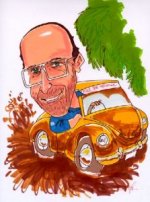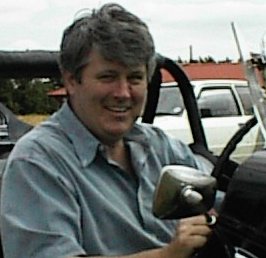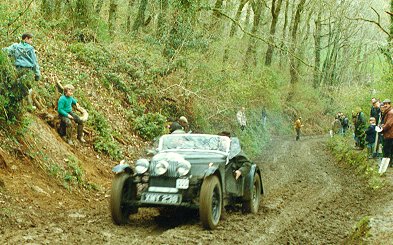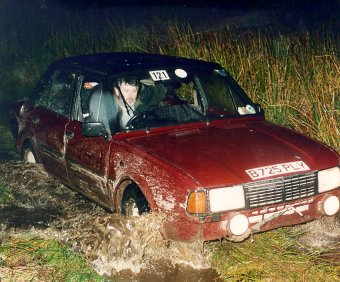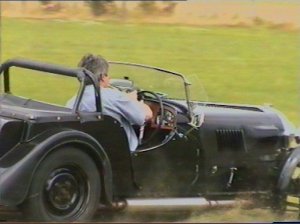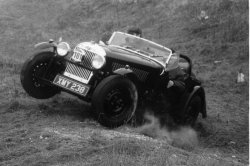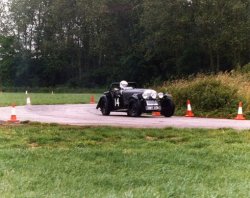by Myke Pocock
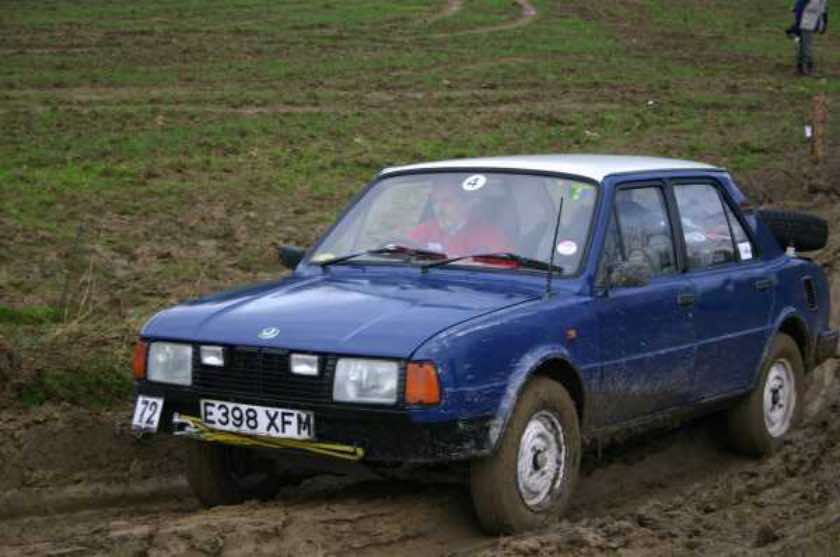
The Allen was to be my 2nd ACTC trial and my 4th in total having failed on this years Edinburgh due to mechanical failure due to poor car preparation. No use trying to blame it on anyone else as it was my fault. The plan was to have one last trial in 2004 then possibly the Kyrle next year before my friendly surgeon exercises her, I hope, not inconsiderable talents on my knackered left ankle. Due to the Edinburgh problems Baldricks new semi-independent rear end and accompanying new found ground clearance had not been blooded in serious competition so I was looking forward to a change in the handling characteristics and boy did I get it!
Er’ indoors declined my invite to occupy the left hand seat so a secret weapon in the guise of Chris Veevers was drafted in to offer knowledge and bounce. Whilst Chris had not actually competed on the Allen he and Martin Willis had spectated and video’d in 1999 as part of their research prior to the first Northern Trial. He was therefore able to offer valuable advice from that and previous competitive outings in his old Skoda and more recent Beetle. I also found Michael Leets reports on his site from previous Allens gave valuable information on some sections making tyre pressure choice a little easier. That and the comments freely given by other competitors at the section starts make it such a delight to compete.
With a one way mileage of near on 300 we had decided to travel on the Saturday, B&B overnight, compete and then travel home on the Sunday. Collecting the trailer from Chris’ and loading Baldrick gave little indication of the trauma to follow later in the day. Setting of at a little past mid-day and simply travelling through Carlisle to the M6 gave a little indication that all was not well in the handling department but it was on to the motorway and increase speed only to discover that at anything over 50 the trailer started to snake slightly. Chris then announced that I had loaded the trailer up with the car facing forward and consequently the engine was at the back. Not exactly conducive to good handling! We stopped at the next junction to re-organise. Was this going to solve the problem? Setting off back on to the motorway showed little improvement. My God, this journey at 50 was going to take some time. After a few more fishtails I was getting increasingly worried then the BIG ONE. Going down hill and a little over 50 everything happened. It must have looked spectacular as the cars in the middle and outside lane anchored up and put their hazards on. Was that just to look at the entertainment or were they worried as well? I suspect the latter. We immediately turned around, set off back home where the trailer was substituted for our club A frame then got back on to the road, some 3 hours later than planned. We decided that the combined car and trailer weight was simply too much by far for my tow vehicle. A lesson learned with, fortunately no drastic outcome.
Due to our delay we arrived in the area beyond 9pm and failed twice to find somewhere to get a meal. Ironically we finally managed to get fed and watered at The Cross House, the trial start venue and 2 minutes drive from our B&B.
Following signing on the following morning and a pretty comprehensive scrutineer we had time to chin wag and drool over some of the assembled machinery. Chris was particularly interested in the Beetle spare wheel carriers on display as his failed on the Ilkley Trial and a new one is planned. It looks like one manufactured from large section tube as fitted to Giles Greenslades new Class 6 Beetle will fit the bill.
Eleven minutes past ten saw car 72 set off for Section 1, Tog Hill where, with 18psi in the tyres, we had an easy run to the top to shake things down well for the rest of the day. There then followed a 10-mile road section to the next section. This involved passing some earlier competitors cars well covered in mud prompting an in car discussion on just what lay in store at Birch Hill. On arrival we were greeted by a queue of at least 15 cars waiting to cross the field to the start of the section. In threes they set off, some having trouble even with the ruts on the access track to the section. The return of a Marlin and Dellow down the track certainly put in question our ability to clean the section. Anyway, after a good half hour we set off and had a brief wait at the section start with time to drop the tyres to 12 before our chance. From my research I knew to keep momentum going to the right hand deviation into the field and that there was a patch of clay to negotiate. Some understatement that!!! What a cracker. We were faced with a field covered with deep tyre tracks in thick mud from previous cars and my thought was no way were we to get though THAT. However Baldrick had other ideas and we kept going, and going,……. and going but I was convinced that as it got a bit steeper we would bog down. Not a bit of it and with Chris’ instructions shouted in my ear to “Keep going Myke, we haven’t finished the section yet”, we cleared the brow of the hill and negotiated the mud lagoon in the corner of the field before the road, declining the route book request ‘to stop there and remove mud’. I don’t think so. We now had the answer to why all those cars were mud covered.
A further 7 miles or so saw us tackle Bitton Lane which eludes my memory apart from our note that it was stony and muddy with a tyre pressure of 12 this time and we made the restart OK and cleaned it. It was then on to Guys Hill which I knew slightly having seen it on the video. No restart for us Class 4’s on this one and 12 psi once again but we ran out of puff at the 3 marker after generating a good quantity of tyre smoke. Perhaps we should have kept the tyres a bit harder but it probably wouldn’t have made any difference as it was pure power that we lacked.
A further short run to the two Special Tests where 1 went OK and 2 is best forgotten about with an over run on the CC line. Now, I had decided that a quick time was not necessarily required as I wouldn’t be in line for class honours but a fail was definitely not on the agenda. However, when push comes to shove and the red mist comes down you go for it don’t you? What a difference 6 points made in the results. If my leg had been long enough I would have kicked my own backside.
The next Section was Travers Hill which we noted as a rough section with much banging from the underside and, following a clean and run out at the top of the section I detected a familiar noise from the front end. My Edinburgh this year had started and finished after the first section due to a failure of the two lower shocker mounting bolts on each side at the front end. This was due to me raising the front end by swapping the wishbones side to side and failing to re-weld the mounting nuts. This time it appears that one new weld has failed but the bolt was still captive so apart from a slight rattle battle could continue. Nevertheless I double checked the bolt at the following lunch halt but all was in good and useable nick.
After feeding and watering ourselves it was a short run to another of my top hills of the trial, Burledge. Again we had something of a wait here, cars being allowed up in threes to the start which gave us time for another chin wag, some research on how to drive the section and what pressures where advisable. There was also a rather tasty Lotus 6 parked at the bottom that got my attention. It was here that Harvey Walters came hurtling back down to the holding area and parked it on the verge with gearbox selector problems. Once again we dropped pressures to 12 and we knew that there was a ridge across the section shortly after the start needing a bit of care but after that it turned slightly right, increasing in steepness, getting narrower and narrower and the ruts deepening towards the top. Once again a terrific hill but I don’t think we could have got any better than our 4, simply running out of grunt, but how the hell does Adrian M clean that hill with 1300cc?
It was now getting towards dusk as we headed to Nanny Hurns where we passed a sad looking Class 8 parked up by the roadside having lost its offside rear wheel. Once again I had something of an idea of what to expect, or thought I did. as Chris had also videod this hill. I liked this one too but thought there was no way we would get around the bend. Baldrick, however, had other ideas and with something like a wall of death technique, the banking keeping us on line, we shot round the bend with me expecting the section to go on and on. Not so as it ended just a little further on.
By the time we got to Little Uplands headlights were needed and we had to negotiate what looked like seriously deep puddles in the lights on the track to the section start. After a short wait all I can recall were some serious bumps on this one, looking far worse than they were I suppose as the headlights cast large shadows. The last hill of the day, John Walker was also known to Chris and I know he had been looking forward to this all day. Following a brief stop in the holding control, time to drop pressures to 10 I think, we were at the start. The marshal reported that the water in the beck was not to deep so remembering Chris’ instructions to take care through the beck we set of, once clear of the water giving it some stick as instructed. After the slight deviation about half way up it seemed to get rougher and rougher, at one stage the whole of the front end lifting off and crashing down. Terrific!!! With about ¾ of the section complete we were just about celebrating our success when I suddenly lost traction. Suspecting that the gearbox had jumped out of gear I pushed the clutch peddle down and the gear-stick forward with no apparent result. Drop the clutch again and boot the throttle, but slightly suspecting that we had stopped for a brief moment, we slowly but slowly crept to the top of the section and parked on the road. Inspection revealed that we had rolled a near side rear tyre off the rim, at the time I thought due to probably having the pressures too low. The well of the wheel was polished down to bare metal with no hint of paint with the friction and spinning of the tyre Had we made it though? On Chris instructions I ran back to the marshal who, with a comment that was music to my ears, announced that “I will give you that one”. Subsequent investigations a few days later revealed the failure had been due to two adjacent cuts in the outer side wall of the tyre of about 1 and 11/2 inches caused presumably by a sharp rock.
A quick change of wheel, a short drive back to the Cross House, sign off at about 6pm then back to the tow car to set off home. We finally got home at about 12.30 after a cracking days sport. Baldrick had run a treat with the new semi-independent rear end and raised ground clearance performing as hoped for. All there is to do is fit a new tyre, weld the shocker mounting and apply a little delicate momentum to a club hammer to knock some dents out of a couple of wheels.
My thanks to Chris Veevers for acting as passenger and mobile expert and to Bristol Motor Club for a very enjoyable and well run event. Finishers certificates individualised with competitors names was a nice touch as was the short article from the organisers that accompanied the results that arrived by post a few days later.The problem is, of course, as I begin to experience all these cracking competitions I want to do them again every year. Cost and mileage will prevent that one though so it is nice to see that Ilkley Motor Club are to become members of the ACTC and to hope that their trial will become a regular fixture in the North of the country.. Wouldn’t it be nice for us northern competitors to see more new trials in this neck of the woods. Who will be next to organise one? A Scottish club perhaps?
Myke Pocock with Chris Veevers and Baldrick.
We have been publishing stuff about Classic Trials on the Web since 1995 and always appreciate feedback. Comments, Corrections, Criticism & Concerns are all welcome. You can leave a comment to have your say here on this web site or our Social Media
